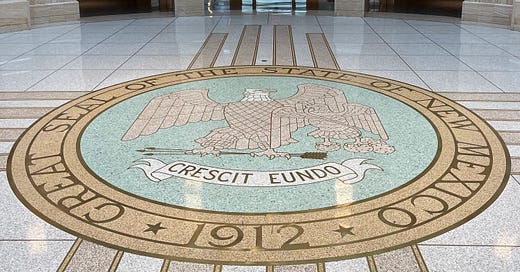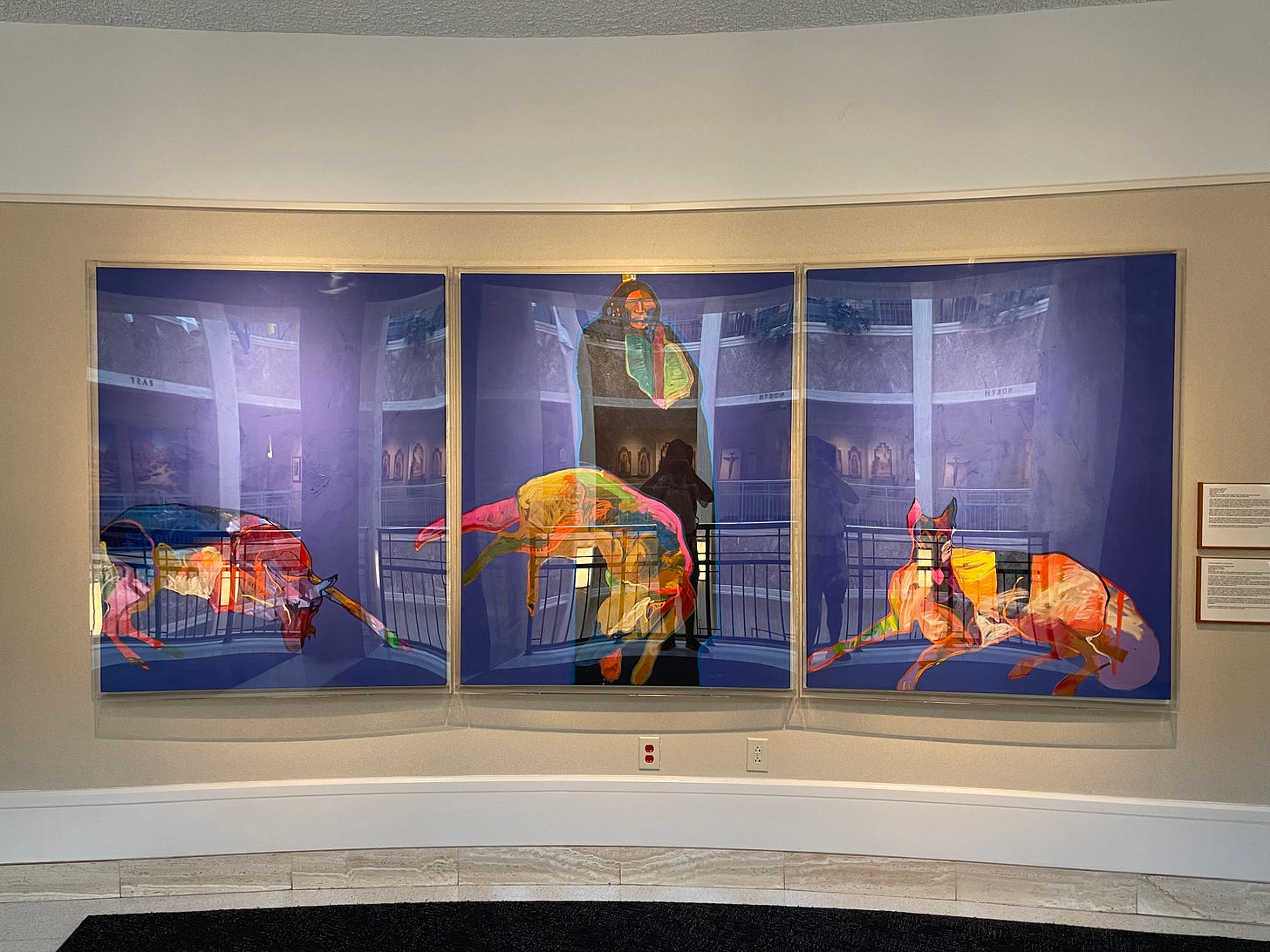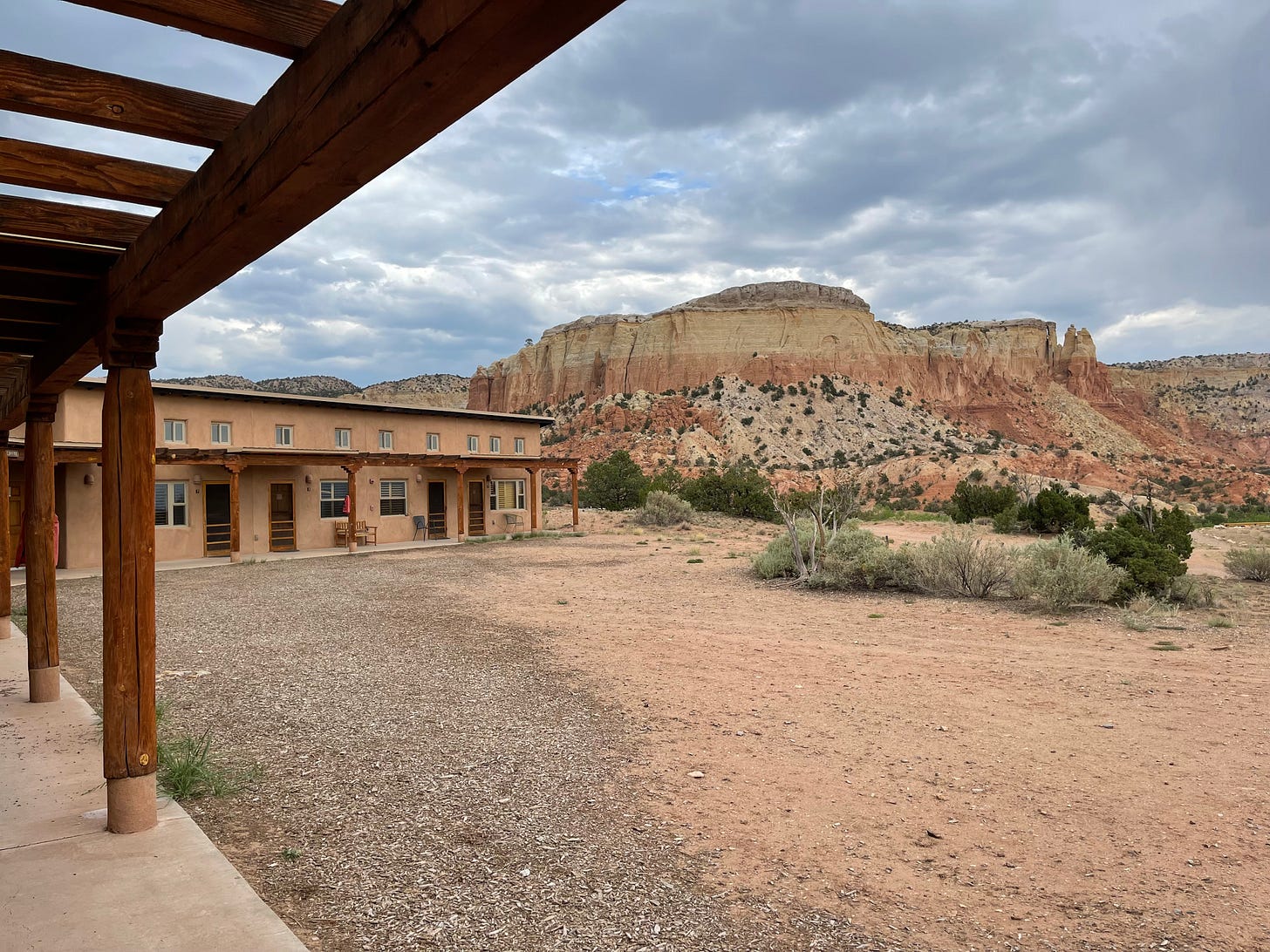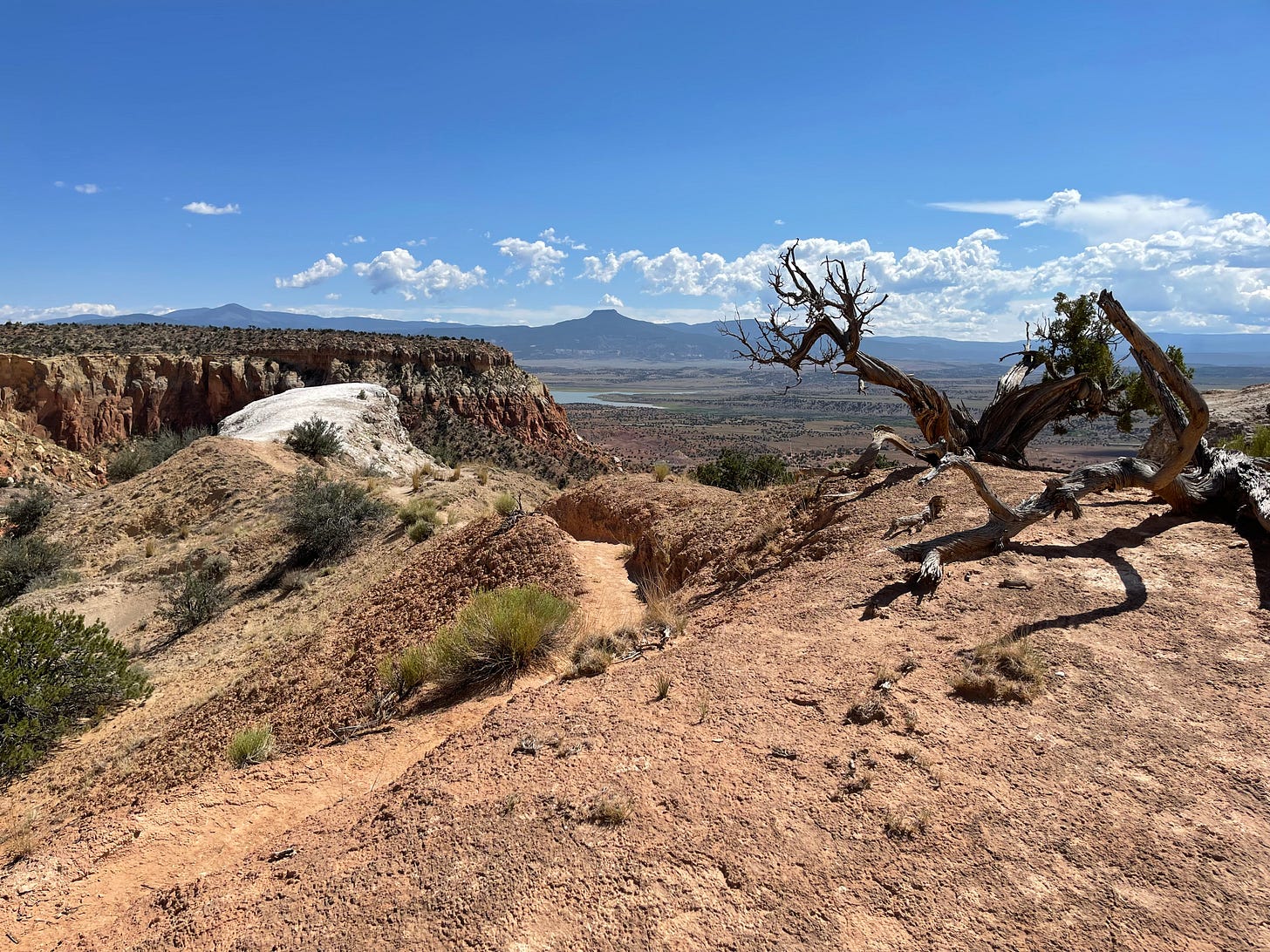Rotunda of the New Mexico State Capitol in Santa Fe
I spent much of last week in New Mexico, first in Santa Fe and its environs for a couple of days, seeing the town, poking into art galleries, and doing a day trip to Bandelier National Monument to hike; and then at the Ghost Ranch, former home of Georgia O’Keefe, where I attended a writers’ retreat organized by the Austin Film Festival. It was a truly delightful experience which I’m going to be thinking about for a long time, but I wanted to get some thoughts down here before it fades too far.
First of all: Santa Fe. I had somewhat mixed feelings about the town. The town center is obviously organized around tourism, in a way that is familiar to me from other tourist towns from Cusco, Peru to Juneau, Alaska. It wasn’t crowded, which was nice for me, but that only made me fret for the viability of the place in our Covid era of reduced tourism. And more generally, I’m always put off a little bit by any place that puts so much of its energy and identity into selling itself to outsiders.
But the difference I felt in Santa Fe was that I really felt the presence of a community of artists. You can walk through the gallery districts of New York, in Chelsea or DUMBO, but there’s not the same feeling that they’re part of a local industry, and certainly not the feeling that the artists are from around there. By contrast, the gallery districts of Santa Fe (I visited Canyon Road and the Railyard District) felt like the real heart of the town, like this is what the town was there to make. Not everything was local by any means; I saw paintings from Russia and bamboo art from Japan as well. But by the same token plenty of galleries were run by the artists themselves, and if the collectors of Native American art gathered their offerings from all over, well, Santa Fe seems like a particularly suitable place to gather them to. Poking in and out, I felt less like a tourist and more like a buyer, if that makes any sense, even though I didn’t buy anything.
That feeling that art really was the local industry was powerfully reinforced by my visit to the State Capitol, which is basically set up as an art gallery, with a wide variety of local artists working in different media and styles represented:
I wouldn’t say I saw anything particularly avant garde, but honestly I don’t even know what that phrase means anymore—and anyway, that’s kind of the point. The stuff on display wasn’t either pure kitsch nor an attempt to make a intellectual statement; it was all, well, stuff one could imagine somebody buying for display if they had the money and space and it suited their taste. You know: art. And the fact that the entire building was filled with it (as you can see in the reflections of some of the images above) felt like a testament to its status as a key local industry more than anything, which is precisely what a public building like this ought to tout.
All of which made me feel very warm toward the place. From an economic perspective, having art be a key local industry isn’t great; art is fundamentally a luxury good, and it’s hard to build mass prosperity on the back of a luxury goods business. But from a cultural perspective, it felt quite nice to feel like art was an industry aimed at filling a normal human need for beauty and meaning rather than a pure game of status competition.
The other thing that really struck me was that I could wander around the Capitol at will. I never had to sign in, never had to walk through a metal detector, never had to show identification, never had to confront armed guards. I cannot recall the last time I had an experience like that in New York. It felt like freedom, and it felt really good. I’m tempted to believe that the difference has something to do with New Mexico being a smaller state, and Santa Fe being a sleepy town. Turns out, what I experienced was a restoration, as a security fence that was erected after January 6th was taken down at the end of March.
So if I can credit the culture of New Mexico with anything, it’s a willingness to reverse course on the kinds of security measures that, in New York at any rate, have tended to become permanent.
The retreat at Ghost Ranch was a different kind of luxury good, more about time than about money, as the fee for the program was by no means exorbitant. I didn’t wind up doing a lot of writing there, other than the exercises I did in the group sessions. But those exercises were instructive, and I hope I remember the instruction.
I’ll describe one in particular. We were asked to name (1) three landscape features that we had noticed at the ranch, (2) three different types of weather we had experienced, (3) three times we had gotten lost (not necessarily at the ranch), and (4) three times we had felt betrayed (ditto). Having done that, we were told to circle one of the three choices in each category, then to think of a character from a piece we were working on, and write a monologue in that character’s voice that connected all four of the choices we had circled. We were given ten minutes to write and then we had to share our work out loud.
I found the exercise incredibly stressful. My heart was pounding, and I started cursing out loud, no doubt disturbing the other participants. I hadn’t really thought ahead to what the exercise might be, so my examples in each category were really specific—and none of them pertained to the character that I had chosen in my mind. Indeed, some of them were so specific to me that I didn't know what I was supposed to do to connect them with this fictional person, which was part of why I was freaking out.
And then, I let go, and wrote this:
I thought it was like the perfect place you know? What it’s like when you find the perfect place, where you can just be? After that talk with David, I knew I had to find a place like that. Somewhere I could think—and I found it. Framed against the sky like a monument, and it was a monument. There was a memorial plaque on the side, some dude who’d built this place or restored it or something—some dude nobody would know if they didn’t go up that rock.
So I had to climb it, and I had to go all around to find good footholds. And when I made it to the top, I tried to think what he would do in my place. I know, I don’t know him—but I got me into this mess, right? I don’t want to know what I would do; I wanted to be him. Someone who would be remembered.
And then the rain came, all of a sudden out of nowhere, a cloud just rushing in to blow across the sun, and I was drenched. And somehow I knew that I could still get clean. It was like when Richard hit me, and I hit him back, and afterward he came up to me and tried to blame me for it, and I said no: you are a teacher, you do not hit a student. And he said: maybe you’re right, and I said: you know I’m right. And the kid next to me whispered: well said. And then I could cry.
Those tears made me clean, just like the rain made me clean. And if I can find the right words, maybe I can cry again. Be clean again.
Anyway, I came down and the ground was all gray mud. I lost my shoe and it took so long to get back that I was frantic, and had to change super quick, pack up, and race to the airport. And then I went to the wrong one. Is that a sign, I wonder.
Now, that is not deathless prose. It’s full of clichés, it’s insufficiently specific, it doesn’t actually create a dramatic situation—I can’t say much good about it. But I can say this: it’s not incoherent, and I wrote it in ten minutes.
Like many writers, I’m a huge procrastinator, and I don’t have great personal strategies for combatting the urge to procrastinate. Mostly I give into it until things get desperate. So one lesson from the exercise that I might have taken is: you need things to be desperate. Set deadlines—even better, timebox, so that every minute is put to use, even if that use is as a break. Taylorize your writing process, and you’ll be amazed at how much comes out.
I don’t rule out that lesson, though I will be frank, I resist it. Because I don’t think my problem is fundamentally that I dawdle while writing; once I’m in it, I’m in it. The problem is starting. And part of the problem with starting is the prompts. What the leader of our group did with that exercise, from my perspective, wasn’t primarily set a deadline, but set the prompts—or, rather, enable us to set them in a semi-arbitrary way. The page, in other words, wasn’t blank anymore; there was something there to respond to, and we had no choice but to respond to it.
That’s my main takeaway: not that I need to set deadlines, though I do need to do that, but that I need to be more ruthless about creating prompts for myself, and less picky about what the prompts are. Make a choice and go, and then revise the choice if it proves fruitless. I’m very reluctant to do that, and I need to get over that reluctance and its associated preciousness. My time isn’t so valuable that I need to save it for the perfect prompt, and it is far too valuable to waste it waiting for the perfect prompt.
Anyway, everything else about my time at the ranch was absolutely delightful. The veteran writers they brought in to speak to us were truly inspirational and I made some real friendships among the attendees that I hope prove enduring. And I do mean friendships; I didn’t feel like what we were doing was networking so much as sharing and comparing, learning from each other.
And then there’s the setting, which I can’t do justice to with photos, but just imagine stepping out of your room to this every morning:
Right?
I’ll close with a few more pictures, even though it’ll make me miss the place even more.
















